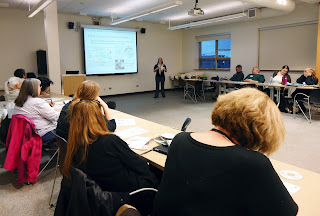IISG’s Molly Woloszyn organized a workshop for several Chicago-area teachers recently, and wrote us to share news of the event.
—-

On January 31st, I had the opportunity to help organize and present at a workshop for several Chicago Public School teachers titled “Climate Change: What Is It and What Does It Mean for Illinois?” The workshop attendees all lead after school conservation clubs for 6th-12th graders through the Chicago Conservation Corps (C3), a program of the Chicago Department of Transportation.
C3 project coordinator Kristen Pratt invited me to speak to the teachers about the basics of climate science and climate change. I did this workshop in collaboration with the Illinois State Climatologist, Dr. Jim Angel, who enriched the workshop by sharing his abundant knowledge on the climate of Illinois, as well as projections for the future of Illinois’ climate.
After receiving feedback from the teachers, I was thrilled to hear that they learned a lot about climate science and climate change, a topic that is very important to them and especially relevant nowadays. Many teachers said they found it valuable to learn what is happening with the climate in Illinois and more specifically in Chicago.
The topics I spoke to the teachers about included climate variability, the natural controls of climate and climate change, the influence humans can have on Earth’s climate system, the greenhouse effect, and the main sources for greenhouse gas emissions in the United States and Chicago.
Not only were the teachers enthusiastic to learn about the topic, they were also eager to share the information with their students, which I think is one of the best results from the workshop.
The mission of the C3 Student Clubs Program is to recruit, train, and support a network of teachers and students to improve the quality of life in their schools and neighborhoods through environmental service projects that protect water, clean air, restore land, and save energy.

